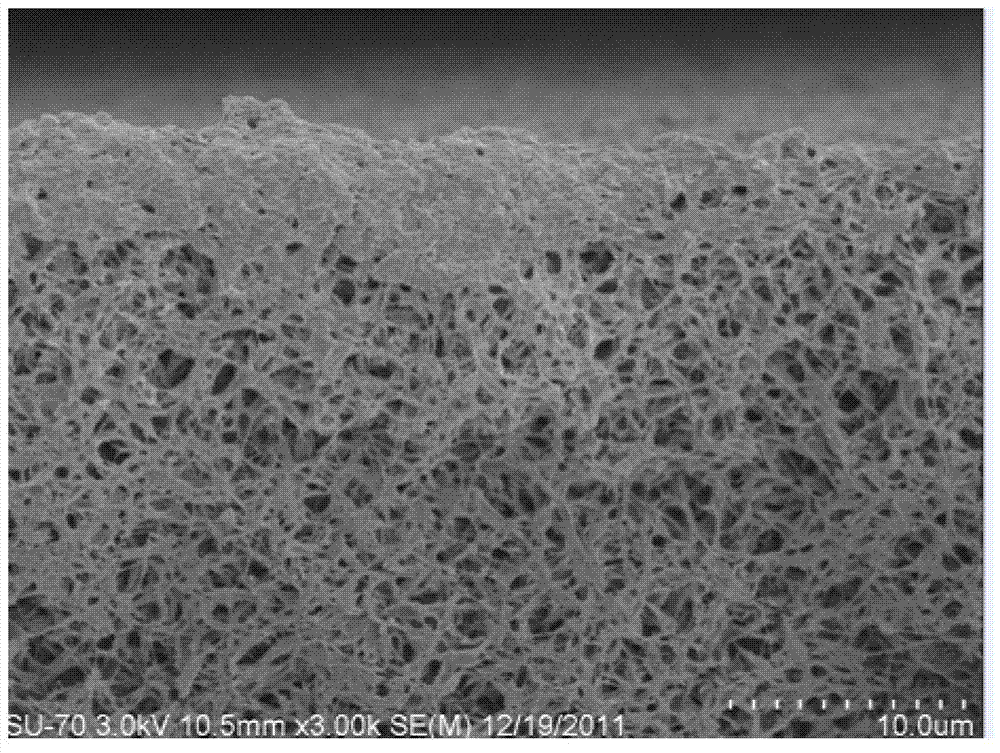Method for preparing polyvinylidene fluoride alloy film
A polyvinylidene fluoride and alloy membrane technology, applied in chemical instruments and methods, membrane technology, semi-permeable membrane separation, etc., can solve problems such as unfriendly environment, difficult cleaning, complicated process, etc., and achieve reduced production costs and easy cleaning , good performance
- Summary
- Abstract
- Description
- Claims
- Application Information
AI Technical Summary
Problems solved by technology
Method used
Image
Examples
Embodiment 1
[0020] Example 1: Accurately weigh 185g of caprolactam, 60g of polyvinylidene fluoride, and 2.5g of polyvinylpyrrolidone. Stir the above three raw materials evenly and pour them into a 500mL jar with a stopper. Under the condition of slow nitrogen protection, use oil Bath heating, the temperature of the oil bath used is 140 ° C, heating to completely dissolve the raw materials, and keeping at 140 ° C for 45 minutes, then stirring the solution with an electric stirrer for 30 minutes, and then standing in the oil bath for defoaming to obtain the casting solution , and then keep the casting solution at 140°C for preservation. Pour the obtained film-casting solution into a template and scrape it into a film, place it in the air to cool naturally until it is completely solidified, and then put it into water to dissolve the diluent caprolactam to obtain a polyvinylidene fluoride alloy film. The thickness of the vinyl fluoride alloy film was 125 μm.
[0021] The SEM image of the mor...
Embodiment 2
[0023] Example 2: Accurately weigh 182.5g of caprolactam, 62.5g of polyvinylidene fluoride, and 5.1g of polyvinylpyrrolidone. Stir the above three raw materials evenly and pour them into a 500mL jar with a stopper. Under the condition of slow nitrogen protection, Heating in an oil bath, the temperature of the oil bath used is 150°C, heating to completely dissolve the raw materials, and keeping at 150°C for 1 hour, then stirring the solution with an electric stirrer for 30 minutes, and then standing in the oil bath for defoaming to obtain a cast film solution, and then the casting solution was kept at 150°C. Pour the obtained film-casting solution into a template and scrape it into a film, place it in the air to cool naturally until it is completely solidified, and then put it into water to dissolve the diluent caprolactam to obtain a polyvinylidene fluoride alloy film. The thickness of the vinyl fluoride alloy film was 120 μm.
[0024] The pure water flux of the polyvinyliden...
Embodiment 3
[0025] Example 3: Accurately weigh 177.5g of caprolactam, 62.5g of polyvinylidene fluoride, and 10g of polyvinylpyrrolidone, stir the above three raw materials evenly, pour them into a 500mL jar with a stopper, and use Heating in an oil bath, the temperature of the oil bath used is 160 ° C, heating to completely dissolve the raw materials, and keeping at 160 ° C for 1.5 hours, then stirring the solution with an electric stirrer for 45 minutes, and then standing in the oil bath for defoaming to obtain a cast film solution, and then the casting solution was kept at 160°C. Pour the obtained film-casting solution into a template and scrape it into a film, place it in the air to cool naturally until it is completely solidified, and then put it into water to dissolve the diluent caprolactam to obtain a polyvinylidene fluoride alloy film. The thickness of the vinyl fluoride alloy film was 115 μm.
[0026] The pure water flux of the polyvinylidene fluoride alloy membrane prepared in ...
PUM
| Property | Measurement | Unit |
|---|---|---|
| thickness | aaaaa | aaaaa |
| thickness | aaaaa | aaaaa |
| thickness | aaaaa | aaaaa |
Abstract
Description
Claims
Application Information
 Login to View More
Login to View More - R&D
- Intellectual Property
- Life Sciences
- Materials
- Tech Scout
- Unparalleled Data Quality
- Higher Quality Content
- 60% Fewer Hallucinations
Browse by: Latest US Patents, China's latest patents, Technical Efficacy Thesaurus, Application Domain, Technology Topic, Popular Technical Reports.
© 2025 PatSnap. All rights reserved.Legal|Privacy policy|Modern Slavery Act Transparency Statement|Sitemap|About US| Contact US: help@patsnap.com

